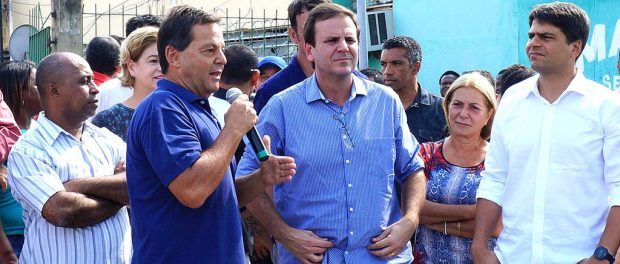
Six years ago, the 51 available City Council seats in Rio de Janeiro were all up for grabs in the 2012 election and 1,741 candidates were vying for votes. Each voter could choose only a single candidate out of the 1,741, with no district-based voting system to narrow down their options. Two years ago, 11 candidates were vying for the mayoral seat. In such crowded races, candidates use whatever means available to win. In these and essentially all other elections across Brazil, electioneering—the practice of taking an action such as currying favors or making promises solely to attract votes (with no commitment to seeing promises through)—is rampant. And this process serves to sour voters on the democratic process.
Self-interested at best and malicious at worst, electioneering is always harmful. It misleads voters to either thinking they are acquiring “the only good that comes from elections,” in the form of a favor in the lead-up to voting (like jerseys for a community team, or a fixed-up playground), or, in worse cases, that their vote is going toward promised community improvements or policies that ultimately will not be realized.
The promises made by these politicians of changes that will benefit constituents are often abandoned once a candidate has been voted into office. Furthermore, many of these promises are shallow to begin with, like when they fail to align with what communities have identified as the most urgent needs, or when there is realistically no funding available for their implementation. With the 2018 elections just six months away, remembering the recent history of electioneering in Rio may help voters resist being tempted by devious (or poorly planned) promises and use their votes—and broader democratic engagement—more productively.
Electioneering: Recent Examples
Despite the enthusiasm it garnered both among favela residents and among urbanists and architects, Morar Carioca is one of the most obvious recent examples of electioneering in Rio de Janeiro. Commitment to the favela upgrading project, which initially promised to upgrade all Rio favelas by 2020, appeared to run in lockstep with the election cycle. After the program was launched in 2010, needs assessments in priority communities began in the mayoral election year of 2012, the same year then mayor Eduardo Paes gave a widely acclaimed TED Talk featuring the initiative. While the program generated excitement among many favela residents who saw desperate need for the promised upgrades, some were right to be skeptical. Funding was cut abruptly in January 2013 following Paes’ reelection, and over the following months it became obvious that communities that had received promises and even initial assessments had been abandoned. The few projects that were implemented under the Morar Carioca label failed to align with what residents identified as the most urgent needs, foregoing the participatory planning process that had been such a lauded element of the program.
Then, the program finally seemed to start progressing again in 2016—another mayoral election year—but after a three-year delay residents of favelas like Pica-Pau, where even the re-launch event was canceled and postponed, were understandably skeptical. Once again, little was delivered.
But Morar Carioca isn’t the only example to call on. Vila Autódromo Residents Association president Altair Guimarães recalled an example of electioneering in the form of a children’s park, an easy visibility project built by a candidate during an election year. The park was then left to deteriorate without maintenance or equipment and the community faced displacement rather than further investment.
Geographically-based communities aren’t the only populations to be targeted by electioneering politicians; fishermen are one example of a different social group that has been targeted by these campaigns. Several initiatives promised to benefit them have fallen short just like those for favela communities. Take, for example, the inauguration of a R$37 million sewage treatment center that promised to improve Guanabara Bay water quality but which never entered into full operation. A lawyer representing fishermen from Sarapuí in the Baixada Fluminense reflected: “Politicians use the fishermen when they want to win an election, then disappear.”
Evidence points to the 2018 elections following suit. The National Security Plan proposed in July 2017 for implementation earlier this year called for an inter-departmental effort to counter violence, in part through a package of social programs in Rio favelas, but the telltale signs of electioneering were visible to favela leaders: the programs seemed to be reinventions of previous ones without clear plans for overcoming the mistakes made before, and the sources of funding were unclear. As Favela em Pauta reported, the president of the Federation of Favelas of the State of Rio de Janeiro (FAFERJ) said: “Always at the time of elections, they come up with this weak program that does not solve [the issues], it’s a palliative for the communities. And we don’t want a palliative [remedy]. We want something concrete…” In Rio, implementation of the National Security Plan was delayed, and then shunted aside by the federal military intervention declared in February.
Many Voters Aren’t Fooled
 The reality is, while politicians may think they are getting the best of voters, with experience building up every two years since Brazil re-democratized thirty years ago, everyday Cariocas can now spot these election-trophy policies from a distance. Back in 2012, a number of favelas in Curicica, in Jacarepaguá in the West Zone, were awaiting Morar Carioca investments. Ivan from Vila Calmete‘s Residents Association flatly predicted that “the investments might end as soon as the upcoming election is won.” Another resident, from Vila União de Curicica, explained how politicians regularly proposed low-commitment, low-impact short term projects to present a good image and build support. She had come to expect that politicians would not show the same interest in maintaining those investments, like the poor quality wooden footbridges installed in Vila União, reflecting “we have to fix their mess ourselves.”
The reality is, while politicians may think they are getting the best of voters, with experience building up every two years since Brazil re-democratized thirty years ago, everyday Cariocas can now spot these election-trophy policies from a distance. Back in 2012, a number of favelas in Curicica, in Jacarepaguá in the West Zone, were awaiting Morar Carioca investments. Ivan from Vila Calmete‘s Residents Association flatly predicted that “the investments might end as soon as the upcoming election is won.” Another resident, from Vila União de Curicica, explained how politicians regularly proposed low-commitment, low-impact short term projects to present a good image and build support. She had come to expect that politicians would not show the same interest in maintaining those investments, like the poor quality wooden footbridges installed in Vila União, reflecting “we have to fix their mess ourselves.”
Just this year, Manguinhos resident Daiana de Oliveira gained attention and appreciation on social media after a video showed her giving a speech in front of Rio’s governor, Luiz Fernando Pezão, warning him residents wouldn’t be fooled into voting a certain way just because he was reopening the Manguinhos state library in an election year. She later wrote on Facebook: “The reopening [of the library] is politics, we know this. It’s an election year after all. But we have the right to culture, reading, and education. We’re not going to trade this library reopening for votes. They, the state government, are doing no more than their obligation.”
A refrain that emerges from reflections on electioneering in Rio is the lack of participation, which would drive projects that address communities’ most urgent needs. Participation is legally required in planning and development projects, but is rarely harnessed effectively in policies and interventions by government officials.
André Constantine is the Residents Association president in Babilônia, a favela in Rio’s South Zone that did receive a small percentage of promised projects under the Morar Carioca label before the program was abandoned. But the level of community participation fell far short of what the policy promised on paper. He reflected: “[Morar Carioca] is a shame. That this project is winning awards is even more shameful still. The reality is no dialogue at all. They changed the project various times. When you are going to make a change in this type of project, you have to ask the residents again. Nothing like this was done. Nothing like this was realized. Like everything that comes with the State here, it comes from the top down.”
This can be infuriating when local residents have knowledge that can create simple solutions. In the case of the Sarapuí fishermen who were blocked from reaching their fishing grounds by eco-barriers installed for the Olympics, the fishermen themselves had a solution: moving the eco-barrier further up the river where it would not block their path. “No one consulted the fishermen,” one of them said after sharing the solution.
Other favela residents are worn down by electioneering tactics: Elis, a 46-year-old resident of Vidigal, opted not to pay attention to the 2016 mayoral debates: “It’s a lack of time and also lack of interest. They always promise the same things and do none of it. They even campaign here, but only to deceive the people.”
A Vicious Cycle
The insidiousness of the election-trophy policies may lie in the vicious cycle this practice creates: potential voters experience politicians wasting their time and energy with empty promises, giving them reason to disengage from the political system, resulting in a less politically educated electorate which is actually more susceptible to clientelism when they go to vote, as is required by Brazilian law. Both candidates and voters are incentivized to accept these tactics and the cycle repeats. In a setting where no one is held to account for the promises made during campaigning, voting may not be enough for meaningful democracy.
What To Do
This lack of accountability has allowed electioneering to proliferate, leaving voters exhausted from disappointment, confused about what to believe, and tempted to disengage. At best, the practice can be seen as ‘just’ a self-interested tactic used to get votes; at worst it is an under-handed strategy to de facto disenfranchise voters by creating an environment in which votes feel meaningless and so name recognition or favors matter more than platforms or policies.
In either case, Rio residents intent to express their rights through the vote can resist the impacts of electioneering by considering the following questions as they consider who to vote for, based on the electioneering examples we have documented on RioOnWatch over the years:
- Does the politician have a track record of following through on promises for projects that serve favela communities?
- Has the politician dialogued with community associations, collectives and organizations, particularly in a public forum?
- Does the project align with the community’s urgent needs, identified by a participatory planning process?
- Is funding for the project viable?
- If the project is building on something that already exists or existed, does it have a public plan for addressing previous failures?
Distrust in this context is healthy. But giving up isn’t. Voters need to be vigilant, be skeptical, and vote smart. And demand measures of accountability and reforms to stem the future flow of electioneering promises.

